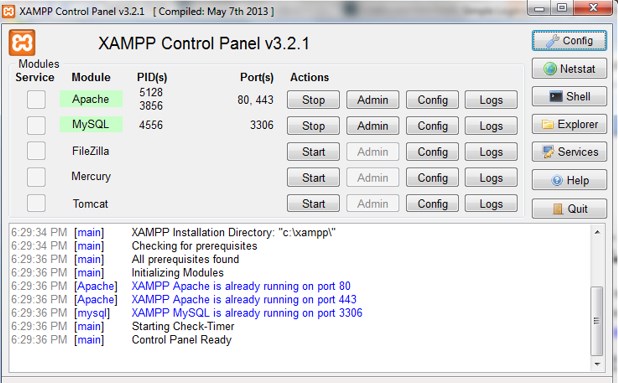Hey guys, in this tutorial I will show how to create a login script using PHP and MYSQL. The local server used in this tutorial is XAMPP. If you don't have XAMPP you can download here.
What you have to do after installing XAMPP?
- Go to
Startand open XAMPP control panel - Start Apache and MySQL. It should look like below figure

- Now you can close the XAMPP control panel.
Create our database and tables
- Open your browser and type
http://localhostin the address bar. - Click on
phpMyAdminon the left side as shown below.

- On the left side of the new page you will see the list of available databases
- Choose one of these databases and create a table inside by clicking on `New' like in the image bellow

In the above figure I created new table inside the databaselearn and the table name is echocodea. Any name can be given has a table name.
The structure of the table echocodea:
CREATE TABLE `echocodea`(
id int(11) NOT NULL auto_increment,
username varchar(50) NOT NULL default,
email varchar(50) NOT NULL default,
password varchar(50) NOT NULL default,
PRIMARY KEY (`id`)
) What you have to do after creating database?
- Create a new folder to keep your project in; for example
SignIn - Open your favorite text editor(notepad, sublime text, etc) and create a new file. Name it
index.phpand save it in your folderSignIn. - Copy and paste the below code in
index.php
<div id="login">
<div id="sub_login">
<h5 id="log_head">LogIn</h5><hr>
<span><?= $error;?></span>
<form action="checklogin.php" method="post">
<input type="text" name="username" placeholder="USERNAME">
<span><?= $fields_error;?></span><br>
<input type="password" name="password" placeholder="PASSWORD">
<span><?= $fields_error1;?></span><br><br>
<input id="log_submit" type="submit" name="submit" Value="LogIn">
</form>
</div>
</div>
- After creating
index.phpcreate a new file and name itchecklogin.php. - Copy and paste the below code inside
checklogin.php.
<?PHP
session_start();
$fields_error = "";
$fields_error1 = "";
$error ="";
if(isset($_POST['submit']))
{
if(empty($_POST['username']) || trim($_POST['username']) =='' )
{
$fields_error= "Username is required";
}else {
$username=htmlspecialchars($_POST['username'], ENT_QUOTES, 'UTF-8');
}
if(empty($_POST['password']) || trim($_POST['password']) =='' )
{
$fields_error1 = "Password is required";
}else {
$password = password_hash($_POST['password'], PASSWORD_DEFAULT);
}
if(empty($fields_error) && empty($fields_error1))
{
$connection = mysql_connect("localhost","root","");
$db = mysql_select_db("learn", $connection) or die("cannot select DB");
$result = mysql_query("SELECT * FROM echocodea WHERE username='$username');
$data = mysql_num_rows($result);
if($data){
if(password_verify($password, $data['password'])){
$_SESSION["username"] = $username;
echo htmlspecialchars(strip_tags($_POST['username']), ENT_QUOTES, 'UTF-8');
}else{
$error = "OOOPS..Username or Password is wrong!!!";
}
}else {
$error = "OOOPS..Username or Password is wrong!!!";
}
mysql_close ($connection);
}
}
?>
In the above code, this portion allows us to initialize error variables with null value
$fields_error = "";
$fields_error1 = "";
$error =""; .
if(isset($_POST['submit']))This indicates if login button is pressed in index.php.
if(empty($_POST['username']) || trim($_POST['username']) =='' ) and
if(empty($_POST['password']) || trim($_POST['password']) =='' ) {checks whether the username and password field are empty or not. If any of the field is empty then it displays the error message if not empty then the username and password are respectively stored in $username and $password.
if(empty($fields_error) && empty($fields_error1))Checks whether the error variables declared at the beginning are empty or not. If there are empty, it means every was fine then the below code will be executed.
$connection = mysql_connect("localhost","root","");This is connection to the database server.
$db = mysql_select_db("learn", $connection) or die("cannot select DB");This line will now check in our table if there is a user who has this uername and password store before.
$result = mysql_query("SELECT * FROM echocodea WHERE username='$username' ");This line selects the results of the above query and stores in $data.
$data = mysql_num_rows($result);This following 3 lines check if there is record that corresponds to our username and password. If there is, then that username is $username and we display ( echo htmlspecialchars(strip_tags($_POST['username']), ENT_QUOTES, 'UTF-8'); ) the given user name to show the user that his username and password match with our records.
if($data){
$_SESSION["username"] = $username;
echo $_SESSION[“usernameâ€]; If there is no such username or password then it prints username or password is wrong.
Finally mysql_close ($connection); closes the connection to the database.
- Again let's create a new file for styling the form with the name
style.cssand write the below code inside it.
#login {
width: 30%;
margin-left:10%;
margin-top:0.5%;
font-family: 'Raleway', sans-serif;
}
#sub_login {
width: 95%;
padding: 2% 8% 7%;
border: 2px solid gray;
border-radius: 10px;
font-family: raleway;
margin-left:0%;
margin-top:1%;
}
span {
color:red;
}
#log_head {
padding: 6% 8%;
margin: 2% 4%;
text-align:center;
border-radius: 10px 10px 0 0;
font-size:200%;
}
#log_submit{
padding: 10px;
font-size: 18px;
background: linear-gradient(#069 5%, #068 100%);
border: 1px solid #ccc;
color: #fff;
font-weight: bold;
cursor: pointer;
width: 96%;
border-radius: 5px;
margin-bottom:10px;
}
#log_submit:hover {
background: linear-gradient(#069 5%, #068 100%);
}
input[type=text],input[type=password],textarea{
width: 95.7%;
height: 30px;
padding: 5px;
margin-bottom: 5px;
margin-top: 5px;
border: 2px solid #ccc;
color: #4f4f4f;
font-size: 16px;
box-shadow:inset 0 1px 2px rgba(0,0,0,0.18);
}
.forgot{
text-decoration: none;
display: block;
float: left;
margin-top: 5px;
margin-left: 5px;
color:blue;
}And we're done!
I used mysql_* extension which is deprecated today and can be a serious security issue (refering tosql injections). So, in a serious project I prefer you use mysqli_* or pdo. Check out here an example of how pdo can be used: Create a simple news site with PHP and MySQL using PDO
Thanks for following, if you like share.
Last updated 2024-01-11 UTC